February 2, 2018
Air Date: February 2, 2018
FULL SHOW
SEGMENTS
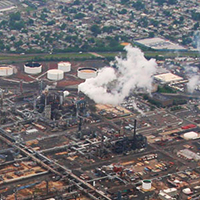
More States Fight Global Warming
View the page for this story
Virginia is the first coal producing state to take steps to join the Regional Greenhouse Gas Initiative – known as RGGI – and New Jersey’s new Democratic Governor has vowed to bring his state back into the compact. RGGI is a Cap-and-Trade carbon-pricing program already shared by nine Northeast and Mid-Atlantic states. Since 2009 it has reduced greenhouse gas emissions some 40% and produced nearly $3bn for clean energy improvements. Host Steve Curwood discussed these developments to the RGGI program with Jackson Morris, Eastern Energy Project director for the Natural Resources Defense Council. (06:45)
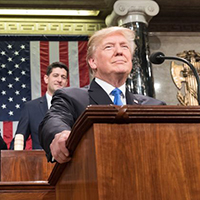
Beyond the Headlines
/ Peter DykstraView the page for this story
During his 2018 State of the Union Address to Congress, President Trump declared he has “ended the war on beautiful, clean coal”. Peter Dykstra joins Steve Curwood to talk about other topics mentioned in the speech – and those left out. For this week’s history lesson, the pair look into a still-missing disarmed atom bomb lost in a US Air Force accident near Savannah, Georgia. (04:03)
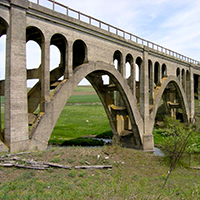
Science Note: Self-Healing Concrete
/ Hannah LossView the page for this story
Maintaining concrete structures can be expensive and time consuming. Living on Earth’s Hannah Loss reports on new research that suggests using fungi that can grow to repair cracks could provide an effective and sustainable solution to crumbling infrastructure. (01:50)

Pulling the Plug on Mega-Dams
View the page for this story
Big dams have been big business in Brazil for the last decade or so but in the wake of scandals and protests the Brazilian government recently called a halt plans for more mega dam construction. Mongabay reporter Sue Branford tells host Steve Curwood that the news is welcomed by both environmentalists and indigenous peoples. (07:58)

Budweiser Brews Green
/ Jenni DoeringView the page for this story
The most popular global beer brand is going green, with a sustainable power purchase agreement to make all its U.S. products with energy from an Oklahoma wind farm. Living on Earth’s Jenni Doering found cheers for the decision among Bud drinkers at a bar in Cambridge, Massachusetts, and Budweiser’s Vice President of Global Marketing, Brian Perkins, told host Steve Curwood why the company feels it’s a smart move for business as well as the planet. (08:42)
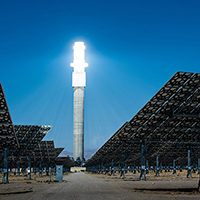
Saving Solar Energy With Salt
View the page for this story
Solar energy is a renewable resource, but the sun doesn’t always shine. Using molten salt to capture and store heat captured from the sun promises to save solar energy for use well into the night. Reporter Rob Dieterich joins host Steve Curwood to explain why this technology can compete with natural gas-fired power and is cheaper than grid-scale battery arrays for photovoltaics. (11:08)

The Place Where You Live: Rose-Hill, Mauritius
View the page for this story
Living on Earth gives voice to Orion magazine’s longtime feature where readers celebrate their favorite places. In this week’s edition, Ameerah Arjanee describes the sights and sounds of her childhood home town of Rose Hill in Mauritius, a small island off Africa’s east coast, and why she’s now looking at it with new eyes. (05:38)
Show Credits and Funders
Show Transcript
HOST: Steve Curwood
GUESTS: Jackson Morris, Rob Dieterich, Sue Branford, Brian Perkins
REPORTERS: Hannah Loss, Jenni Doering, Peter Dykstra
[THEME]
CURWOOD: From Public Radio International, this is Living on Earth.
[THEME]
CURWOOD: I'm Steve Curwood. While the Trump government tries to block climate action, two more states are joining a regional greenhouse gas initiative for power plants.
MORRIS: As far as what the program has delivered to date: We've added at least 2.9 billion dollars to the economy of the RGGI states. We've also added 30,000 job years to the region's economy, and it's raised 2.7 billion dollars that the states have then reinvested in clean energy.
CURWOOD: Also – why the best selling beer in the world is going to 100% carbon-free power.
PERKINS: We went and talked to beer drinkers all around the world. And we found that climate change is pretty much the number one social concern, particularly for younger beer drinkers, younger consumers. And we thought that it was time that we contribute towards solving (that problem or at least getting people talking about) that problem.
This Bud’s for the planet and more this week on Living on Earth – Stick Around!
[NEWSBREAK MUSIC: Boards Of Canada “Zoetrope” from “In A Beautiful Place Out In The Country” (Warp Records 2000)]
[THEME]
More States Fight Global Warming
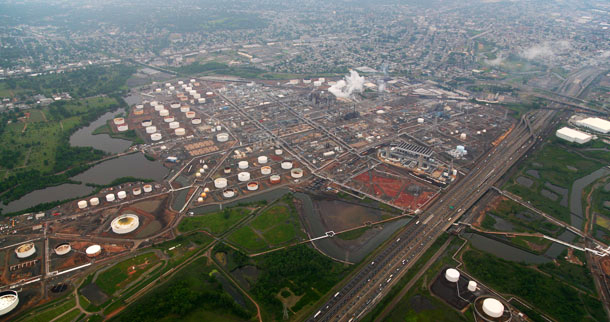
A bird’s-eye view of a power plant in Linden, New Jersey. (Photo: Doc Searls, Flickr CC BY 2.0)
CURWOOD: From PRI, and the Jennifer and Ted Stanley Studios at the University of Massachusetts, Boston, this is Living on Earth. I’m Steve Curwood. While the Trump Administration moves to block the Clean Power Plan that would reduce carbon emissions from electric generators, two more states are joining the Regional Greenhouse Gas Initiative (RGGI) that cuts emissions in nine Northeast and Mid-Atlantic states. This Cap and trade program that puts a price on carbon has exceeded its reduction goals since it began in 2009.To tell us more, we turn now to Jackson Morris, the Director of the Eastern Energy Project for the Natural Resources Defense Council – he’s on the line now in New York. Welcome to Living on Earth Jackson!
MORRIS: Thanks.
CURWOOD: So, the Jersey governor Phil Murphy has recently signed an executive order that begins the process to bring New Jersey back into the Regional Greenhouse Gas Initiative, and it looks like the state of Virginia is also going to join, So, what will that mean for the Regional Greenhouse Gas Initiative, if and when these states get involved?
MORRIS: Well, what we are seeing right now is that states that are interested in climate action and tackling carbon pollution from power plants are recognizing that the Regional Greenhouse Gas Initiative is a winning model to address those emissions while driving job creation in the clean energy economy. And in the case of New Jersey we're now going to be capturing and capping and reducing more carbon pollution when you add in the power plants in New Jersey, and for folks in New Jersey it's going to mean cleaner air and greater investment in clean energy jobs when it comes to solar, wind, and energy efficiency.
CURWOOD: What's the situation with Virginia?
MORRIS: Right. So, Virginia is an extremely exciting example of what some folks would see as a southern state, a more coal-heavy state, showing leadership on climate action, and Governor McAuliffe, who termed out of office just recently, initiated a process where he decided regardless of what's happening in the legislature in Virginia that he needed to step up and show climate leadership using his executive authority – a carbon cap for power plants in Virginia. He explicitly said that he wanted the state of Virginia to adopt that cap and to explore linking with other market-based programs in the power sector so essentially that was code for looking at linking with RGGI.
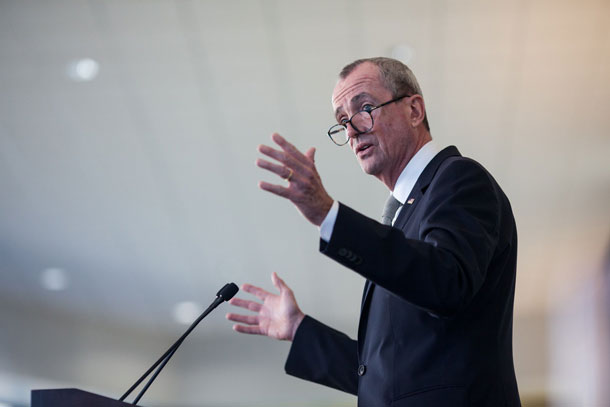
In January of 2018, Phil Murphy became New Jersey’s 56th Governor. (Photo: Phil Murphy, Flickr CC BY 2.0)
He's been succeeded by his lieutenant governor who is the current governor, Governor Northam, who is now following through on that process, and we hope to have the regulation in Virginia, we see that wrapped up over the course of this coming year, and that's again incredibly exciting. The larger the market for carbon is, the lower the cost of meeting the carbon cuts are, and so that's exciting from just a low cost of compliance standpoint and I think we're going to see additional states continue to look at the RGGI model as something they may want to explore linking to as well, to cut carbon and grow their clean energy economies as well. So, I don't think this is a one-off. Once we see New Jersey back in that will be the tenth RGGI state. Virginia would take it to 11 when they link with the market, and I think it's eleven and counting at this point going forward.
CURWOOD: So, explain to people what the Regional Greenhouse Gas Initiative is, how it came to be and the states that are now currently involved.
MORRIS: So, going all the way back to 2003, 2004, Governor Pataki, a Republican governor in New York, began looking at not only policies that New York State could adopt, but how could we start to tackle climate change from a regional perspective, and over the course of a few years of engaging with states in New England, in the Mid-Atlantic, those states agreed that the best way to tackle carbon pollution from power plants in the region would be to pursue a market-based system that caps the emissions from power plants in those states. That was a very much a bipartisan project. We had Republican governors, we had Democratic governors. That bipartisanship continues today. Right now the current nine states, you’ve got five Republican governors, you've got four Democratic governors supporting not only the program in its current form but having supported a big agreement to strengthen the program and extend it out to 2030.
CURWOOD: So, talk to me about the amount of reductions in greenhouse gas emissions that this program's been able to accomplish.
MORRIS: Sure. The program actually kicked in in 2009, and so in 2009 there was a cap on emissions from the region that declined two-and-a-half percent each year going out to 2020. There's been various updates to the program over the years, but the big, kind of big picture number you want to look at is that if you look at the emissions from 2009, and you look at what emissions will be from the power sector in 2030 as a result of that new agreement, you're going to have slashed carbon pollution from power plants in the region by 65 percent.
CURWOOD: And what's the number from 2009 to today?
MORRIS: That would be roughly 40 percent, and as far as what the program’s delivered to date in addition to that 40 percent reduction in carbon pollution, we've added at least $2.9 billion dollars to the economy of the red states. We've also added 30,000 job years to the regions economy and it's raised $2.7 billion dollars in revenue that the states have then reinvested in clean energy.

Jackson Morris is the Director of the Eastern Energy Project with the Natural Resources Defense Council. (Photo: courtesy of the NRDC)
CURWOOD: So, you know, percentages those numbers are kind of abstract. Can you give me kind of a concrete example of that people might be able to relate to regarding these reductions?
MORRIS: Sure. So, as a result of the updated program announcement from last August, the RGGI states are going to cut an additional 132 million short tons of carbon by 2030, and that's equivalent to avoiding one year's worth of emissions from over 25 million cars, so we're talking about a serious volume of carbon pollution being eliminated from the atmosphere as a result of that new agreement.
CURWOOD: So, beyond the reductions, Jackson, what are the program's other benefits? Talk to me about public health.
MORRIS: This is a really important point because while RGGI is a program to cut carbon pollution, as you can imagine, as the power plant sector is forced to cut that carbon, it essentially means it has to be made more efficient and cleaner. And so in addition to those carbon cuts that are so important from a climate perspective, you've got a lot of other pollution that is being reduced as well as the power sector is forced to clean up.
CURWOOD: What do you think that's worth, by the way, in terms of avoided health expenses? Any idea?
MORRIS: It's been estimated using some analysis that some public health experts have done that it adds up to roughly $5.7 billion dollars in public health benefits to date.
CURWOOD: So, that's more than the cost of this program of reducing greenhouse gas emission.
MORRIS: Exactly. And again those are kind of they’re very real and very definite benefits, but it's pretty striking to see that the program is already a net benefit to the region before you even calculate in those public health benefits.
CURWOOD: Jackson Morris is the director of the Eastern Energy Project with the NRDC. Thanks so much for taking the time with us today, Jackson.
MORRIS: Thank you, Steve.
Related links:
- More on the Regional Greenhouse Gas Initiative
- New Jersey Gov. Phil Murphy’s RGGI order
- Virginia’s plan to link up with RGGI
- Jackson Morris NRDC Profile
Beyond the Headlines
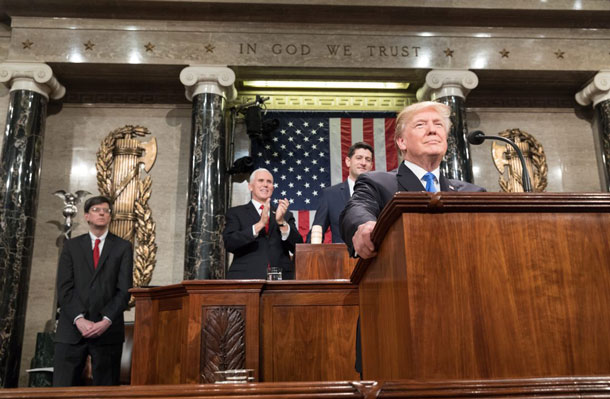
While delivering the 2018 State of the Union Address, President Trump claimed that his administration had “ended the war on American energy,” as well as the “war on clean coal." (Photo: Shealah Craighead, official White House photographer, Wikimedia Commons [Public Domain])
CURWOOD: Time now for a look-see behind the headlines with Peter Dykstra. Peter is with Environmental Health News, that’s ehn.org and Daily Climate.org and joins us now on the line from Atlanta, Georgia. Hi there, Peter!
DYKSTRA: Well, hi Steve. And by the way, you’re sounding very presidential today.
CURWOOD: Oh really, I sound like President Trump? Hey so what did you think about President Trump’s State of the Union speech?
DYKSTRA: Well, as far as environment and science are concerned, I’ll be brief, because the President certainly was. In past years, we’ve talked about how Presidents of both parties insert a couple of obligatory lines about the environment in the annual speech. In 1993, Bill Clinton talked about cleaning up the troubled Superfund program. A quarter century and four presidents later, that still hasn’t happened. And though it now seems unbelievably quaint, both Richard Nixon and Ronald Reagan said that protecting the environment should never be a partisan or ideological issue.
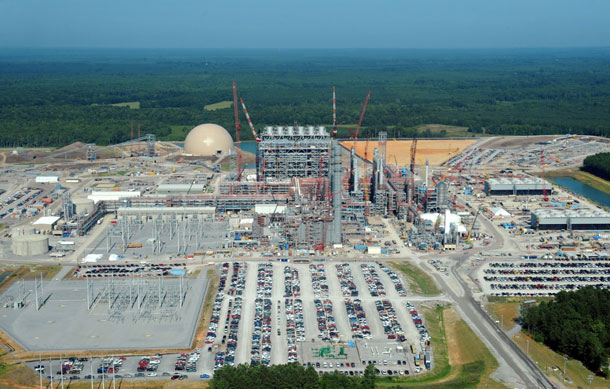
Shown here under construction, the Kemper Project was created by Mississippi Power to use carbon capture technology in order to be the United States’ first “clean coal” power plant. The project lost approximately $7 billion in construction costs before it was announced that the power plant would switch to burning natural gas. (Photo: XTUV0010, Wikimedia Commons CC BY-SA 3.0)
CURWOOD: Yeah, I think that was long ago and far away, Peter. But what about Mr. Trump talking about clean coal and some energy independence?
[APPLAUSE]
TRUMP: We have ended the war on American energy – and we have ended the war on beautiful clean coal.
[APPLAUSE]
DYKSTRA: Okay, let’s start with beautiful clean coal. We’ve had two demonstration projects for burning coal with few or no emissions – one in Illinois, one in Mississippi – and both were billion dollar disasters. At this point, we’ve got better odds of getting clean energy from leprechauns on treadmills than we do from clean coal. Even the most zealous of the coal barons have advised Trump to pull back on his unrealistic promises to revive a dying industry. Natural gas is eating coal’s lunch in the marketplace, and wind and solar are well on the way to putting two more nails in the coffin for domestic coal for making electricity.
CURWOOD: And what about American energy independence?
DYKSTRA: Well, we’d have much more chance of American energy independence, if the Feds, some states and utilities stopped pulling back on the reins on the rapid growth and plummeting costs of wind and solar. Some of the most fossil-fuel-friendly states like Texas and Oklahoma are also cleaning up on wind power.
CURWOOD: Yet Virginia apparently is going to be the first coal producing state to join the Regional Greenhouse Gas Initiative. So since that was just about all the President said about energy and environment, what went unsaid?
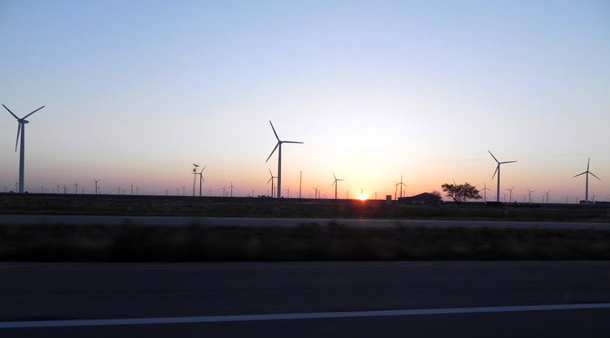
The Roscoe Wind Farm in Roscoe, Texas, is one of the world’s largest wind farms. The Electric Reliability Council of Texas announced that before the end of 2017, Texas’ installed wind capacity had surpassed its coal capacity. (Photo: Fredlyfish4, Wikimedia Commons CC BY-SA 3.0)
DYKSTRA: Well let’s see, here’s a couple of things. In his speech last week at the World Economic Forum in Davos, Switzerland, President Trump went on an extended boast about the American economy – record high stock market, record low unemployment, and more. And a big part of that boast was the assault on regulations – environmental and otherwise – that the White House sees as a drag on American productivity. He tossed out a single line about regs in the State of the Union, and the President avoided the traditional nods toward clean air and water, and other things that many of us consider to be nothing less than a birthright.
CURWOOD: So the cynics would say he wants to make America dirty again? Hey, do we have some time for a quick dip into history?
DYKSTRA: Always! A momentous sixtieth Anniversary for this part of the country. In early 1958, two military aircraft collided over eastern Georgia. The pilots safely ejected and parachuted, but the cargo of one of the planes included a nuclear weapon, which is believed to have ditched near the mouth of the Savannah River.
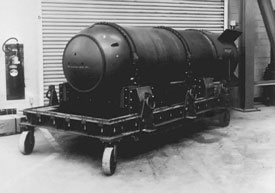
Shown above is a disarmed Mk-15 hydrogen bomb, the same kind that is believed to have fallen just off the coast of Tybee Island after the collision of two USAF aircraft. (Photo: Wikimedia Commons [Public Domain])
CURWOOD: So a bomb in the water near a busy port and some beach towns like Hilton Head and Tybee Island. Tell me they found the bomb?
DYKSTRA: Well it’s only been sixty years, but not yet. Some tabloid reports said that amateur divers stumbled on the bomb, but nothing substantial has been reported. It’s a mystery, just like beautiful clean coal.
CURWOOD: Nice one, Peter. Peter Dysktra is an editor with Dailyclimate.org and Environmental Health News, that’s ehn.org. Thanks a lot!
DYKSTRA: Ok Steve, thanks. We’ll talk to you soon.
CURWOOD: And there’s more on these stories at our website, loe.org
Related links:
- CNN: “State of the Union 2018: Read the full transcript”
- DAILY KOS: “The Tybee Bomb: When the USAF Dropped a Nuclear Weapon on Savannah GA”
[MUSIC: https://www.youtube.com/watch?v=SWJJm2WJ-WA Don Shirley, “Georgia On My Mind,” on Don Shirley’s Best, composed by Hoagy Carmichael/Stuart Gorrell, Cadence Records]
CURWOOD: Coming up – just in time for the Super Bowl, America and the world’s favorite beer goes green! That’s just ahead on Living on Earth, keep listening!
ANNOUNCER: Support for Living on Earth comes from the Gordon and Betty Moore Foundation, and from a friend of Sailors for the Sea, working with boaters to restore ocean health.
[CUTAWAY MUSIC: https://www.youtube.com/watch?v=iyoxXiQvA_E Don Shirley, “Willow Weep For Me,” on Don Shirley’s Best, composed by Ann Ronell, Cadence Records]
Science Note: Self-Healing Concrete
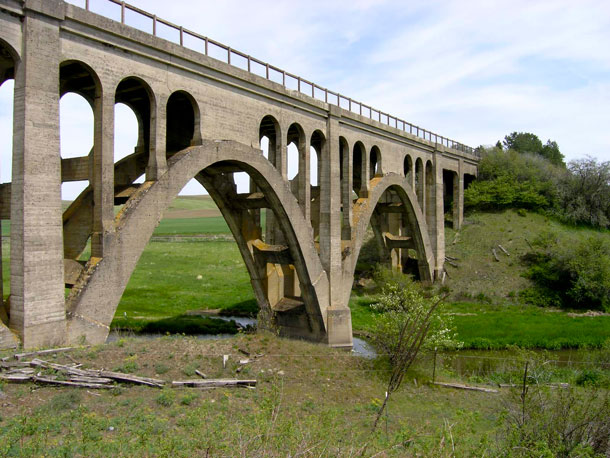
America’s aging infrastructure may benefit from new self-healing concrete. (Photo: Conifers, Wikimedia Commons CC BY-SA 3.0)
CURWOOD: It’s Living on Earth, I’m Steve Curwood. In a minute – pulling the plug on big hydropower in Brazil – but first this note on emerging science from Hannah Loss.
[SCIENCE NOTE THEME]
LOSS: Every day, millions of Americans drive over bridges and speed through train tunnels. At the core of much of this infrastructure is concrete, the grayish mix of cement paste and rocks that has been used in construction since the Romans. Over time and with exposure to the elements, concrete can develop cracks that put structures at risk.
The disintegrating concrete on dams, and spillways, and shielding nuclear power plants is a particular threat to Americans’ health and safety. Now, researchers at Binghamton University are trying to mitigate the effects of cracked and crumbling concrete by bringing this vital building material to life. They created a concoction of concrete with some special ingredients: spores of the fungi Trichoderma reesei and the nutrients it needs to grow.
The spores lie dormant in the concrete until cracks appear. Water and oxygen can then infiltrate the cracks and wake up the Trichoderma spores. As the fungus grows, it creates calcium carbonate, the hard substance that composes oyster shells. The calcium carbonate deposits eventually fill in the original crack. Once the crack is filled, there’s no more space for oxygen or water, so the fungus becomes dormant and forms spores again.
This sort of bioconcrete is still in the early stages of development. Engineers say the biggest challenge is getting the fungus to survive the harsh conditions inside concrete. But once they bridge that gap, self-healing materials could be a smart solution to a global infrastructure problem.
That’s this week’s note on emerging science. I’m Hannah Loss.
Related links:
- Science Daily: “Self-healing fungi concrete could provide sustainable solution to crumbling infrastructure”
- The concrete fungi study in the journal Construction and Building Materials
[MUSIC: SCIENCE NOTE THEME]
Pulling the Plug on Mega-Dams

Indigenous tribes protest construction of mega dams in the Brazilian Amazon. (Photo: Amazon Watch)
CURWOOD: Massive dams require plenty of concrete, but there are now plenty of political and ecological cracks in plans to build new giant hydropower dams in Brazil. Scandal and protests have prompted the Brazilian government to call a halt to more mega dam construction in the Amazon. For an update, we’re joined by Sue Branford, a Brazil reporter for the environmental news agency, Mongabay. Welcome to Living on Earth!
BRANFORD: Thank you.
CURWOOD: So, talk to me about the history, the recent history, of building mega-dams in Brazil.
BRANFORD: Oh for about the last 20 years, I suppose, they've had really grandiose plans for over 80 big dams in the Amazon basin, and some of them have gone ahead. But as they've gone ahead with them, they have actually found they've got problems with them, and I think some of the problems come back to the fact that they were being funded by the state, by the government, so successive governments took electoral funding from the construction company and then had to find a big project that it could set up so that it could pay the construction companies back, and it got worse over the years. I mean, I about two or three years ago, I was involved in a research project on Belo Monte which is of the largest dam in the Amazon, it's the third largest in the world, and I was interviewing people, engineers and environmentalists, energy experts and I couldn't actually find anybody who thought it was a good project, and in the end I rather concluded that the only reason it was going ahead was because the Workers' Party then which was then in power, needed a big project in the Amazon so it could pay back the construction companies, and that really isn't a very good basis on which to be developing energy in the Amazon.
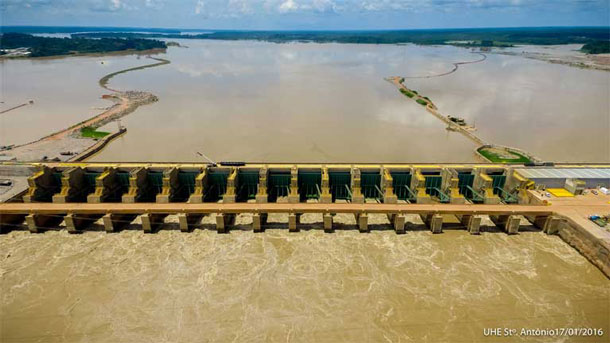
The Santo Antônio dam on the Madeira River, Brazil, part of the Madeira Hydroelectric Complex. An era of mega-dam construction in the Amazon basin that damaged freshwater and forest ecosystems may be coming to an end. (Photo: the Brazil’s Growth Acceleration Program [Programa de Aceleração do Crescimento])
CURWOOD: So, what are some of the problems that these dams have caused from your perspective?
BRANFORD: Well, there's all kinds of problems. I mean, one is that these big dams really do upset the rivers. The river is really central to the survival of the forests. You need what they call a pulse, you need the river water to to rise during the rainy season and then fall during the dry season and sometimes the difference in river level is something like nine meters. And it's lovely in the rainy season, you can go out in a little canoe and go into the canopy of the of the forest. And you can see the fruits and the seeds of the trees dropping into the water. And then when the water goes down this – these seeds and fruit are food for the fish. And if you put dams on the river, you break this up. The river no longer has this pulse, no longer goes up and goes down. So, you are disturbing the whole rhythm of the forest.
CURWOOD: So, let's talk about the indigenous folks who are very opposed to this. I mean, there are many different indigenous groups, but talk to me about a typical protest, a typical opposition to the dams.
BRANFORD: Well, the one I know best is the Munduruku Indians who live on the Tapajós River. There's about 12,000 of them, and they've had a big dam, the Teles Pires dam constructed right near their village. In fact, when they built this dam, they destroyed one of the most sacred sites of the Munduruku. This sacred site is where the people go when they die, that's where their spirits go when they die. And now, they said, we will be killed in two ways. Our lives are being destroyed now by all the impacts of the dam and our future after we die is being destroyed. So, it's a horrific impact. So, when you can see this kind of impact, they are absolutely determined, they're going to stop, put an end to these big dams, and their opposition has been very important.
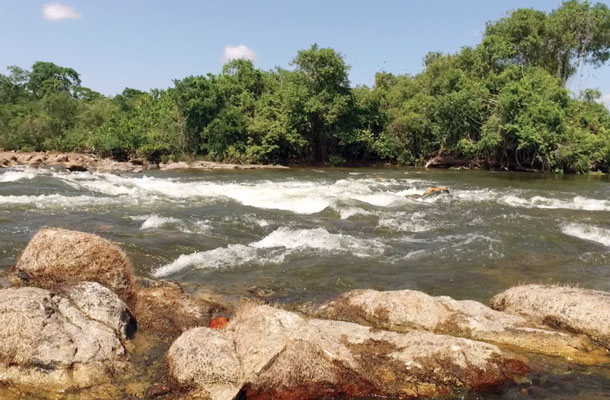
The Tele Pires River stretches 1,370 kilometers (850 miles). Four recently completed dams on that river have done major environmental harm and were met with numerous significant indigenous protests. This week’s announcement by the Brazilian government may save other Amazon Basin rivers from a similar fate. (Photo: Thais Borges)
CURWOOD: So, there were promises about the amount of energy that these dams would produce. To what extent that they meet those promises?
BRANFORD: They haven't met these promises. I mean, I think the worst one is Belo Monte, which is the biggest one. Rainfall has been very unreliable. The Amazon is starting to have quite a lot of droughts, and unless the reservoirs fill up sufficiently, they're not going to generate the energy that was promised. So, they haven't. I mean it's early days for Belo Monte, it's only been operating for a couple of years, but so far the indications are that it certainly won't reduce the amount of energy that was promised.
CURWOOD: So, yes, these were hydroelectric dams that were going to provide electricity to remote areas. How successful were they with the dams that were built?
BRANFORD: Well, this was what we were told by the government, that these dams would provide energy for local people. But in fact, in the majority of cases they didn't. These projects were really geared to big mining projects. Things like bauxite. If you're going to process bauxite into aluminum, you need a lot of energy. This is what they were really about, but for local people, I mean, the number of times I've travelled near a dam, a big dam in the Amazon, and the local people have power shortages, have all kinds of problems with energy because they're just not getting the energy from the big dams.
CURWOOD: Well, so now it seems that the government is going to take at least a break from the dam building business. What exactly happened?
BRANFORD: Well, the government didn't ... the minister didn't actually come out with a very clear announcement that there are going to be no more mega-dams, but some very important leading officials, including a man called Paolo Pedrosa, who the executive secretary of the Ministry of Mines and Energy, really the power behind the throne, he said he thought the period of mega-dams had come to an end. And I think it was basically the realization that they just don't have the money now. I don't think it was so much environmental awareness, it was just that now Brazil has got a right-wing government, a government which is cutting back drastically on the money that goes to state companies, and also if they did push ahead, they were going to get more opposition than ever before that made them think hmm, maybe this isn't the right way forward. And then, of course, solar energy is getting much cheaper. Wind energy is getting much cheaper. It doesn't really make sense for Brazil to invest billions of dollars in these very big projects.
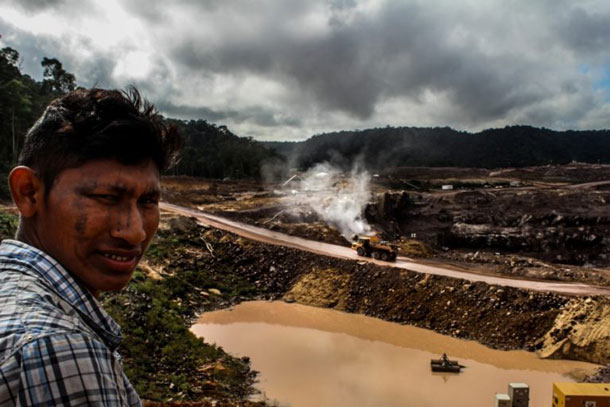
An indigenous leader in April 2015 at the São Manoel dam construction site on the Teles Pires River in the Tapajós basin. (Photo: Midia Ninja, courtesy of International Rivers)
CURWOOD: So, if the lack of money is really behind this pause in dam building. I gather there's no guarantee that they won't build these dams, what about folks with deep pockets who might build them? One has to think of the Chinese, for example.
BRANFORD: I mean that is a possibility. I mean, the Chinese are moving into the Amazon in a big way. What they are fundamentally concerned about is getting Brazil’s soy to get it transported up North so it can go to Asia through the Amazon River. They've helped with the paving of roads. They may be helping with the construction of a big railroad. There is talk of them setting up an industrial waterway which would be pretty catastrophic for the forests, which would mean just that you’d dredge the river and you dynamite the rapids, and then you'd have big barges taking the soy out. But I think there's also a growing awareness among a lot of people that it really does not make much sense to go on cutting down all this forest to create these big infrastructure projects. People know that this will liberate more carbon dioxide into the atmosphere. It will mean that these trees aren't absorbing Carbon Dioxide. It's just making the whole crisis worse. So, I think there is a growing awareness that we do need to stop cutting down the forests, but whether this growing awareness will gain momentum and be sufficient to actually stop that ever deforestation of the Amazon, nobody knows.
CURWOOD: Sue Branford is a Brazil reporter for the environmental news agency MongaBay. Thanks, Sue, so much for taking the time with us today.
BRANFORD: Thanks, Steve. Goodbye.
Related links:
- Mongabay: “Brazil announces end to Amazon mega-dam building policy”
- Living on Earth: Damming the Amazon River
[ISC Jam Session, “Minor Swing,” on Jam Session, composed by Django Reinhardt/Stephane/Grappelli, OMAC-15]
Budweiser Brews Green
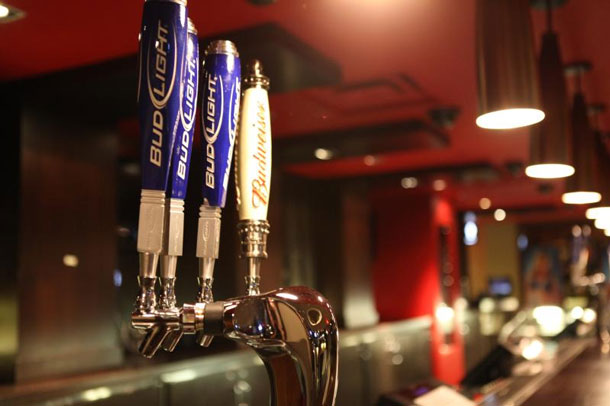
Bud Light and Budweiser taps. Bud Light is the top-selling beer in America. (Photo: Michael Dorausch, Flickr CC BY-SA 2.0)
CURWOOD: On Super Bowl Sunday, more than 100 million people come together around their big-screen TVs and chow down on everything from chicken wings to pizza to celebrate America’s most popular sport. And to make the party even merrier, many crack open a cold one. Often that’s a Budweiser or its sibling Bud Light. And while Bud Light is lighter in calories than most lagers, these days both brews have lighter carbon footprints. Starting this spring, the label on every can and bottle of beer Budweiser brews in America will show it was made using 100 percent renewable energy. So we asked Living on Earth’s Jenni Doering to find out what drinkers think about this popular beer going green – when it’s not St Patrick’s Day. So Jenni, I know this was a tough assignment – where was the information on tap?
DOERING: [LAUGHS] Well, Steve, where do you think? It was on tap along with the beer of course! At the wildly popular Newtowne Grille in Cambridge, Massachusetts. Last Friday night, I ran into Dan there. He’s a faithful Bud Light drinker, and I told him the news.

Dan is a frequent patron of Newtowne Grille and a faithful drinker of Bud Light. (Photo: Jenni Doering)
[SOUNDS OF BAR CHATTER, MUSIC]
DAN: That’s a good thing! Because I mean you have to worry about global warming, and all the energy issues, it’s like, all the natural resources are going away; so we need to start thinking about how to make Bud Light in the future, for our future generations.
DOERING: Over at another table, half a dozen Millennials sat around a pitcher of Budweiser. Ashley is a grad student studying climate change. She thinks this is a big deal.
ASHLEY: I feel like their, like, advantages is in the volume, right? Like, they have such an influence because they sell so much product. So a small change like that, or a big change, can have a huge impact. I definitely applaud that – I think it’s a step in the right direction.
DOERING: The 100% Renewable Electricity label won’t go on Budweiser cans and bottles till April. But Steve, no one is waiting -- right now they seem happy to down a pint – or more – of this popular brew.
DAN: Cheers!
[GLASSES CLINK]
DAN: Score…
CURWOOD: Living on Earth’s Jenni Doering. And by the way Jenni, which one do you like better.
DOERING: Well, Steve, for me it’s gotta be the Bud Heavy, as the Millennials call it.

Millennials raise glasses of Bud Light to the news of its maker Budweiser going green. (Photo: Jenni Doering)
CURWOOD: Thanks, Jenni. So now let’s turn to Brian Perkins, Budweiser’s Vice President of Global Marketing for the inside scoop on these more sustainable suds. Brian, welcome to Living on Earth!
PERKINS: Hi, Steve. Thanks for having me on the show.
CURWOOD: So, Brian, what sells better ... Bud Light or the original Budweiser?
PERKINS: Well, that depends whether you look at the whole world or you look at the United States. Budweiser is the biggest international beer brand in the world and about two-thirds of the sales actually now come from outside of the United States. So, in the US, Bud Light is a bigger beer, but globally Budweiser is the king.
CURWOOD: So, how did this initiative for going green come about?
PERKINS: Look, people have been getting together for beers for over 3,000 years and beers made of natural ingredients, right? So, water, barley, malt, and in our case, rice, yeast and hops. And we ask a lot of the environment to make beer and enjoy beer. And so, if we're the biggest beer brand in the world, and we would very much like people to be getting together for beers for another 3,000 years, then we should make sure that we take a leading role in safeguarding that and making that happen. And so we went and talked to beer drinkers all around the world and we found that climate change is pretty much the number one social concern, particularly for younger beer drinkers, younger consumers, and we thought that it was time that we made a move to contribute towards solving that problem, or at least getting people talking about that problem, which is why we've decided to brew all of our Buds with renewable electricity and put that symbol on our packaging.
CURWOOD: So Brian, describe the logo for us.
PERKINS: Absolutely. So, I think our intent with the logo or the symbol was to be very, very simple, very getable and instantly recognizable. And so the symbol has the shape of a battery, just like you'll see at the top of your iPhone display, and in the middle it says 100 percent and on the top and bottom it says brewed with 100 percent renewable electricity from wind power.
CURWOOD: You want to get people charged up on sustainability?
PERKINS: Absolutely.
CURWOOD: So, you sell your beer around the world. Here in the United States, where you sourcing the renewable electricity from?
PERKINS: Three or four weeks ago, a gigantic wind farm went live. It's called the Budweiser wind farm at Thunder Ranch in Oklahoma. It is owned and operated by Enel Green Power, and its reason for existing is the commitment that we made publicly to source all of our electricity from renewable sources. So, that commitment enabled us to sign a power purchase agreement with Enel and now that wind farm generates all of the electricity required to brew every Budweiser in the United States. So, if you enjoy a Bud today, you can rest assured that it is brewed with 100 percent renewable electricity.
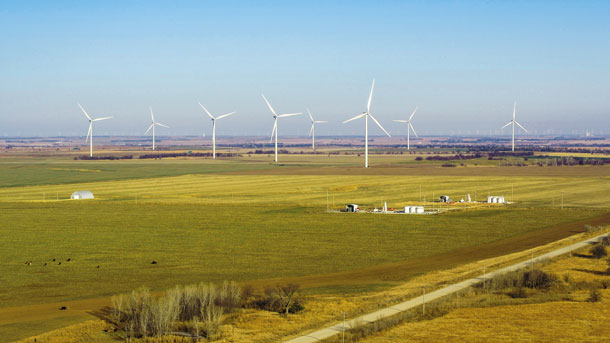
Budweiser has a power-purchase agreement with Thunder Ranch Wind Farm in Oklahoma to provide all of the electricity for its U.S. operations. (Photo: courtesy of Budweiser)
CURWOOD: Let's talk a little bit about economics. Here in the United States, a can or a bottle of Bud Light retails for less than a buck. How do you plan to keep Buds affordable while reducing the carbon footprint? In other words, how much is this costing you?
PERKINS: This is a very important point because the agreement to purchase all of our electricity from renewable sources, we believe is going to be at the same cost as purchasing electricity from coal-fired plants and from non-sustainable sources, and I think that's a good thing for people to start to understand and for businesses to start to understand that the cost of renewable power has been dropping, and now it's actually at a point where it's good for business. So, it was always good for the environment, and now it's actually good for business too. So, there should be no barriers now to us all embracing this and going big with this.
CURWOOD: Now, I understand that you were at the recent session at Davos at the World Economic Forum there. How do people perceive the move by Budweiser here? How did people respond to your view of corporate sustainability in those discussions?
PERKINS: I'll be a very honest with you, I was super nervous because it's a high profile event with a high profile crowd and you know it's not normally the place for beer company. We went there with the intention of announcing our commitment to brew with renewable electricity and to put it on the pack. So, I spent a lot of my time there talking to NGOs who've been trying to crack the problem of climate change and have been trying to bring businesses into the equation for many years. So, they really know what they're doing, and I was talking to them a lot to get feedback, and the other community that I was really there to talk to was other businesses because we would like this symbol to be bigger than Budweiser and bigger than beer. We'd like it to be a symbol that's embraced by many many different brands and consumer products and services, and we'd like it to become a movement. So, to that end we're offering this symbol free of any charge, of course, and we're offering for anybody to use it who shares the same commitment that we do. And since the meeting in Davos last week we've had multiple outreaches from multiple brands and businesses to start to explore the possibility of joining us on the movement and putting this symbol on their packaging.
CURWOOD: Hey, before you go, Brian ... so for the Super Bowl, what are you featuring in the Budweiser ads this year?
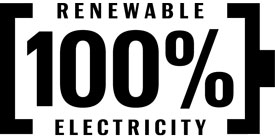
The new 100% Renewable Electricity logo will start rolling out on cans and bottles of Budweiser products in April, and is not trademarked in an effort to entice other companies to switch to renewable energy and use the symbol. (Photo: courtesy of Budweiser)
PERKINS: This year the main focus from Budweiser is a different type of social responsibility message, which is to highlight what we've been doing actually for decades now, which is disaster relief. And so whenever there been hurricanes, tornadoes, earthquakes, etcetera, in the United States which have created emergency situations and water shortages, what we've done where possible is we can quite quickly convert our brewing lines to instead of canning beer, we can purify water, because we make the beer with purified water, and so we can actually just channel the purified water straight to our brewing lines and seal it into emergency water cans. Again, we've been doing it for decades and especially with all of the many natural disasters that have happened in the last 12 months, the message here is about standing by America and being there for America when these disasters happen.
CURWOOD: And climate-related disasters really. Climate has potentiated all those storms and fires and such.
PERKINS: That's what we believe.
CURWOOD: Brian Perkins is Budweiser's Vice President of Global Marketing. Thanks so much for taking the time with us today.
PERKINS: Thanks very much for having me.
Related links:
- FastCompany: “Budweiser’s New Symbol Stands For Every Beer Made With 100% Renewable Energy”
- AB InBev Press Release: “Anheuser-Busch InBev Commits to a 100% Renewable Electricity Future”
[MUSIC: Stand By Me! Ben E King. https://www.youtube.com/watch?v=hwZNL7QVJjE
Album, Don’t Play That Song, Atlantic Records, 1962]
CURWOOD: Coming up, salt as a simple solution to the problem of saving solar energy. That’s just ahead here on Living on Earth, stay tuned.
ANNOUNCER: Funding for Living on Earth comes from you our listeners, and United Technologies – combining passion for science with engineering to create solutions designed for sustainability in aerospace, building industries and food refrigeration. UTC companies such as Otis, Carrier, Pratt & Whitney and UTC Aerospace Systems are helping to move the world forward. You can learn more about United Technologies by tuning in to the Race to 9 Billion podcast, hosted by UTC’s Chief Sustainability Officer. Listen at raceto9billion.com. That’s raceto9billion.com. This is PRI, Public Radio International.
[CUTAWAY MUSIC: Paul Glasse, “New Roux,” on One More Night - disc 2, dos Records]
Saving Solar Energy With Salt
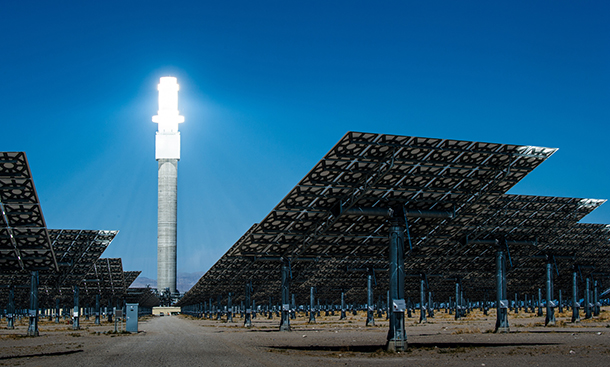
SolarReserve’s Crescent Dunes plant in Nevada trains mirrors on a core tower to heat molten salt that can be used immediately to run a turbine to produce electricity, or stored to make electricity hours later. (Photo: Dennis Shroeder / National Renewable Energy Laboratory, Flickr CC BY-NC-ND 2.0)
CURWOOD: It’s Living on Earth, I’m Steve Curwood. It almost seems like a miracle that simply putting a silicon cell out in sunshine can instantly produce pollution-free electricity, and the solar power business is now a huge growth engine. But the challenge of course, is what to do at night, and at other times the sun doesn’t shine because batteries are still too expensive to use at the scale of the power grid.
One solution may literally be salt. A project that uses molten salt to store heat captured from sunlight demonstrates that huge amounts of energy can be stored and the heat can then power steam turbine electric generators all night long, if needed. Rob Dieterich’s article on this project in the Nevada desert recently appeared on Inside Climate News and he joins me now. Rob, welcome to Living on Earth!
DIETERICH: Hey, thank you.
CURWOOD: So, Rob, I take it that this concentrated solar power or CSP technology, as some people call it, looks a lot different from your typical photovoltaic solar panel array. Please describe for us what the Crescent Dunes system in Nevada looks like.
DIETERICH: Well, when you go out and look at this thing, it is quite amazing. First of all, it's the middle of nowhere, it's in the desert halfway between Reno and Las Vegas and as you get closer to it – even when you're still miles away – you see this 650-foot tower and there are mirrors that are shining light up at the top of it, and it's the brightest day you're going to see anywhere. In the middle the day, in the desert it's still brighter than anything else around. That's where the work is being done, basically the reflected sunlight from the mirrors, from the heliostats, is going up and heating molten salt that's circulating up and down through that tower.
CURWOOD: So, it focuses all this light on the place where the salt is. How hot does it get?
DIETERICH: What they do ... it heats it up to just over 1,000 degrees Fahrenheit.
CURWOOD: Wow.
DIETERICH: And they have two tanks. So then once they heat it up to a 1,000 degrees Fahrenheit it goes into what they call their hot storage tank. It looks like a big tank you would see at a refinery or something. It's like a large tank where they store it, and then on the other side of the plant is the cold storage tank, which is actually itself at 500 degrees Fahrenheit. You don't ever let the molten salt get really cold or what you have is salt, not molten salt.
CURWOOD: So, how does this work? How can ordinary table salt be used to store energy from the sun?
DIETERICH: The way it's used – it is actually not ordinary table salt, it's a different type of chloride, but it is salt – and the way it's used is that by heating this up you've got a really good medium for holding the heat. Once the salt is heated up to a 1,000 degrees and you put it in this insulated tank, it can sit there for days and barely lose any temperature. It basically holds that 1,000 degree temperature. Then what you do is you take that molten salt, you run it through a heat exchanger, and at 1,000 degrees you can create steam whenever you need it. The steam is then used to run what is essentially a very standard power turbine.

The very bright tower where the molten salt is heated can be seen from many miles away. (Photo: Dennis Schroeder / National Renewable Energy Laboratory, Flickr CC BY-NC-ND 2.0)
CURWOOD: And that turns a generator to make electricity.
DIETERICH: Exactly. Yes, just a standard steam turbine like GE provides all over the world.
CURWOOD: You say it's not sodium chloride, which is table salt. What kind of chloride is it?
DIETERICH: It's a blend of sodium nitrate and potassium nitrate, 60-40 of those two salts. Table salt doesn't melt until you get it even hotter than that kind of salt. So, table salt is not as good, though table salt is actually being looked at in some places because you can heat it up even hotter than you can heat up these particular salts. There's a lot of salts in the world.
CURWOOD: So, Rob, of course a key complaint about traditional solar energy is that it's difficult or expensive to store for overnight use, for when the sun isn't shining. By how many hours does storing energy with molten salt extended solar energy's usefulness?
DIETERICH: You could basically run the turbine all the way through the night if you want to. It's all just a calculation of how many mirrors you have, so how much salt you can heat up during the day and then what size turbine you run on it. At Crescent Dunes, the plant that I went out to visit which is the only real commercial scale plant of this type that's operating yet, at that facility they can store enough molten salt to run their target for 10 hours after the sun goes down based on what's in that storage tank.
CURWOOD: Now why did they pick 10 hours?
DIETERICH: These are things that get decided based on sort of what's needed on the grid at a particular place. They could have had slightly more mirrors, right, which would allow them to heat more salt during the day and they could have gone to 12 or 14 hours. So, it's just a calculation of what the grid needs, which is honestly, which is a very important thing because what's missing right now in wind and solar photovoltaics is that you – you make power from those facilities when they want to make power, you don't get to choose. With a plant like this you can set it up so that it runs for however many hours you think you need to meet your peak demand after the sun goes down.
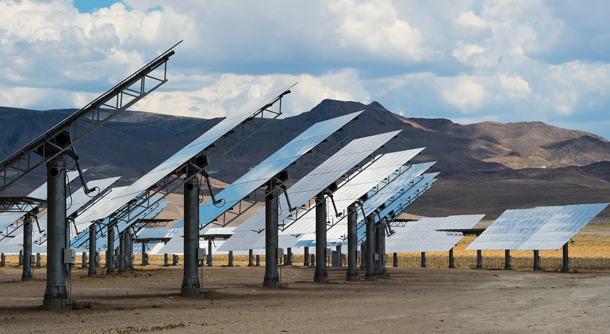
Thousands of large independently-movable mirrors, or heliostats, surround the core tower in a circle measuring about two miles across. (Photo: Dennis Shroeder / National Renewable Energy Laboratory, Flickr CC BY-NC-ND 2.0)
CURWOOD: Rob, battery technology is much improved from what it was even a couple years ago. Companies like Tesla are using that to extend solar energy's usefulness in the nighttime hours. So, I mean to what extent could increasing efficiency of battery storage make the molten salt energy storage obsolete?
DIETERICH: It's a bit of a race. Basically what Tesla and others are putting on the utility grid now are big banks of something pretty similar to what's in your computer, just all joined together, and those prices have absolutely come down and will continue to come down. But thermal storage on a large scale, thermal storage is much much more efficient than battery storage. There’s a belief that with the current chemistry of those batteries until you get some kind of a chemistry breakthrough something that substantially more efficient, where the energy density is that much better, that you're not really going to get to the level where you've got storage on the scale and efficiency of the sort of plant that we're talking about.
CURWOOD: So, let's talk about the money. How expensive is this electricity that's produced by heating up all this salt with these mirrors so that you can then extract the energy at night?
DIETERICH: Well, that's the real wild card and the real thing that got us interested in it is that the prices appear to be coming way down. Basically the company that built Crescent Dunes Solar Reserve, when they got into this business, which is about almost a decade ago now, they were looking at being able to build this kind of plant, and they thought it would be competitive with solar photovoltaic panels. But as you know, as people who follow this now the price of solar PV panels has just plunged, so that's actually cheaper to do now. What is not cheaper is the combination of solar panels and batteries, right?
If you want to get into actual numbers, the contract for the power from solar reserves Crescent Dunes plant is 13.5 cents per kilowatt hour. That was a power contract they signed back in 2009. They now say that they can produce power for less than half that price from the next plant that they're going to build, and they actually have a plant that they expect to be in construction on in Australia, very similar to Crescent Dunes, slightly larger. They expect to get that under construction this year, and they have agreed to sell the power from that for about six cents per kilowatt hour, now that's an important threshold. Six cents per kilowatt hour is kind of the threshold that the Department of Energy and others observing this industry think is the price you need to get to if you're going to be competitive with fossil fuels. If you want to build a solar plant instead of a natural gas plant, six cents per kilowatt hour is about where that could start to happen.
CURWOOD: Now, Crescent Dunes is still one of a kind. I understand that there's a project in Australia, but where else might there be others in the works?
DIETERICH: There's another project that's in construction now built by a Spanish company and that's in Morocco. So, that is coming along and will be finished perhaps this year. There's another plant that should go into construction this year that's in Dubai and then there's companies basically in many places in the world that have projects in the pipeline and hope to get them built. There's been projects bid in South Africa, in Chile where they have really great sunshine, really bright sunshine, which makes this stuff even cheaper, believe it or not, and China is very interested in building these plants as well. They've committed to building several thousand megawatts of concentrated solar power.
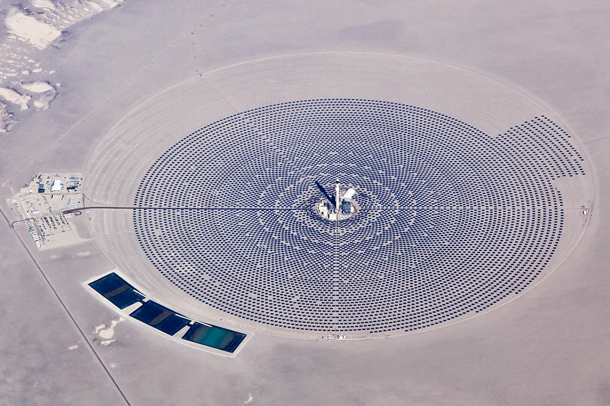
A photo taken from a commercial flight during Crescent Dunes’ construction. (Photo: Matt Hintsa, Flickr CC BY-NC-ND 2.0)
CURWOOD: So, this technology in other words sounds like it works in desert areas because they tend not to rain, tend not to have clouds, and desert areas that are wide-open spaces.
DIETERICH: Yeah, I mean that's one of the obvious limitations. You've got to have a lot of land. The place I visited, that field of mirrors, is 13 million square feet of mirrors, right? It's 10,000 individual mirrors each of which can turn and point towards the sun, at any the hour of the day, turns in two axes, and that field of mirrors is pretty close, I think, to two miles across which is why building in the desert in Nevada is a pretty good choice. There's a lot of room there. And you do have to have super bright sun. Even Dubai where they're going to build another one probably starting this year, there's enough dust in the air that it's not quite as good a location. And as I was saying Chile is a great location. You get, I think, something like 20 percent more power for the same set of mirrors out of Chile just because the solar radiation that hits the ground there is that much more powerful.
CURWOOD: Hey, how safe is producing energy with salt heated to 2,000 degrees?
DIETERICH: Pretty safe. Any time you've got steam pipes and hot stuff going around through a power plant you've – you've got some risk, but this is no more risky and probably less so than you know gas or coal or anything like that. One of the more significant problems they had at Crescent Dunes was they had a leak in that hot salt tank, that big storage tank that they have out there, but when molten salt leaks, it hits the ground which is colder and it turns to salt, which is not the most dangerous thing in the world compared to a leaking tank in a refinery, right, which when it gets out it explodes, and this is, this is pretty safe stuff. You know, one of the things you haven't asked about that people do is, is it safe for birds, is it safe for pilots who might be flying an airplane near one of those bright towers, and those are things to be watched, but we need to keep in mind there doesn't seem to be evidence that it's particularly more dangerous for birds around this than it is around, say, a skyscraper in a city with reflective glass windows.
CURWOOD: So, what's needed to deploy this technology on a larger scale, do you think?
DIETERICH: I think what's needed is to prove it out still. This company Solar Reserves has been around a long time and several other companies have been working on this technology for a long time, and as I say my story the technology that they're using it goes back to a demonstration project that was operated 20 years ago. Even with all that time having passed, we've got just the one operating plant. It hasn't been without its glitches. They feel like it's all worked out and that plant’s running well now, but you've got to build two, three, four more before anybody is going to really be sure that the plants could be built to budget, they could be built on time and that they run the way everybody predicts and that the economics that are being promised when they sign contracts right now can be seen in real life.
CURWOOD: Robert Dieterich is a freelance writer. His story about solar thermal here is in Inside Climate News. Thanks so much for taking the time with us today.
DIETERICH: Thank you.
Related links:
- InsideClimate News: “24-Hour Solar Energy: Molten Salt Makes It Possible, and Prices Are Falling Fast”
- Forbes: “Cheap Renewables Keep Pushing Fossil Fuels Further Away From Profitability – Despite Trump’s Efforts”
- Lazard’s Levelized Cost of Energy Analysis
[MUSIC: Rebirth Brass Band, “Shotgun Joe,” on Ultimate, composed by J. Boudreaux, Mardi Gras Records]
The Place Where You Live: Rose-Hill, Mauritius
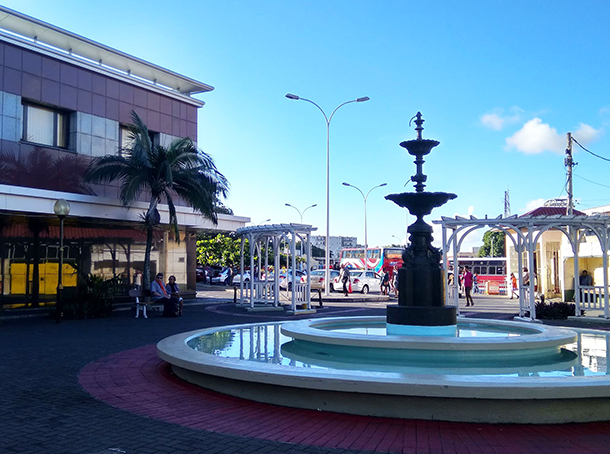
A fountain in Rose-Hill, Mauritius. (Photo: Ameerah Arjanee)
CURWOOD: The warmth of the sun attracts lots of tourists to the small tropical island of Mauritius – where we head now for another installment in the occasional Living on Earth/Orion Magazine series “The Place Where You Live.” Orion invites readers to submit essays to the magazine’s website to put places they care about on the map and we give them a voice.
[MUSIC: Edward Sharpe and The Magnetic Zeroes “Home” from Edward Sharpe and The Magnetic Zeroes (Rough Trade Records 2009)]
CURWOOD: It was the search for magic in the mundane that inspired today’s essay.
ARJANEE: When people think of Mauritius, they usually think of the very tropical touristy things like the beaches and the coast. But my town is sort of a post-colonial, tropical twist on Suburbia. Yet it has this gentleness and rather breezy feel to it.
[MUSIC: Tommy Emmanuel; Anjelina, https://www.youtube.com/watch?v=XWS1IRF_IFA
Album, Endless Road 2004, Favored Nations Records.]
ARJANEE: My name is Ameerah Arjanee and this is my essay about Rose-Hill, Mauritius.
The architectural emblem of my mid-size, mild-weathered town is a municipal hall adjoining an out-of-use theatre from the 1920s. The style of the building harks back to the colonial past, yet it doesn’t have the grandeur or aloofness of similar ones in Port-Louis or Curepipe. For Rose-Hill has always been, at least in my eyes, an unassumingly bourgeois place, peopled mainly by schoolteachers and administrators who look at life with kindness and indifference in equal measure.
In front of the municipal building is a fountain that’s hard to qualify as tasteful or odd. It’s in the shape of a statue of three men helping each other up, a noble gesture, yes, but each body is abnormally elongated, each arm a twisting branch. Every Rose-Hill child has loved climbing up its limbs on Saturday nights, when the sprinklers are off. Her tired parents will sit on a peeling white bench and eat Vona Corona ice-cream cones, grateful for an opportunity to not talk to each other, while the family dog runs through the still-wet grass, chasing an invisible frog. At dusk, a drug addict will come squat in their spot. Close his eyes, kiss the dark.

A church steeple rises above the trees in Rose-Hill, Mauritius. (Photo: Ameerah Arjanee)
During the worst years of my adolescence, this town has felt like a tropical Privet Drive, Surrey. I decided to ignore the Plaza’s hall and odd statue, the old cloth shops of Surtee merchants, the elegant Catholic churches, the bursting colors of the local market, and see only beige, utilitarian buildings. I saw the sidewalks but not the flower-heavy jacaranda trees lining them.
I am now twenty-three, and every day, I try to fall back in love. When I came back from a trip to Mumbai, I noticed how pretty and green this town actually is. There’s a lingering scent of crushed flamboyant petals, mango leaves, tall ferns, and breeze on every walk to the bus station, Chinese corner store or municipal library, if you pay enough attention. I try to now, every time I step out of the house.
[MUSIC: Tommy Emmanuel; Anjelina, https://www.youtube.com/watch?v=XWS1IRF_IFA
Album, Endless Road 2004, Favored Nations Records.]
I think the charm in Rose-Hill is very much like the charm of a town in a Miyazaki cartoon or the small, imaginary town in 100 Years of Solitude. A place which looks very neat and small on the surface but has hidden magic.
One of the things that create this discreet magic is the combination of the quiet presence of trees and buildings that sort of bear witness to the colonial history and waves of immigration of the country. So, you could be walking down a small street and find a beige cement house that would not have any mystery to it, if not for the odd wooden veranda still attached to it and the alcove of a Tamil goddess on the other side of the road.
Or in the Summer, you could be sitting on your balcony and you’d see a row of flame trees over the horizon and there’d be the steeple of a Catholic church rising above the trees and piercing the blue sky. And in the town center you’ll also find old Chinese restaurants made of cool stone. And inside the owner would be serving pork-filled buns alongside Indian sweetmeats. And on the wall, would be the Chinese goddess Guanyin alongside the Virgin Mary. So, at the same time as you’re seeing traces of the different communities that have populated the country, and there’s a bit the sound of the leaves in the breeze in the air and that’s sort of a marriage of the sound and smell of the trees with the cultural richness. And it really sort of reminded me of, like, how magic realism hides in these little things and you have to…you have to really look for it to find it.
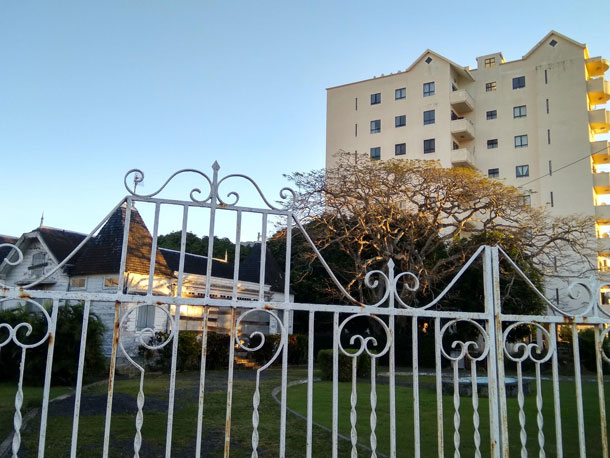
A mix of buildings in Rose-Hill signal the different waves of colonial and immigration history. (Photo: Ameerah Arjanee)
[MUSIC: Tommy Emmanuel; Anjelina, https://www.youtube.com/watch?v=XWS1IRF_IFA
Album, Endless Road 2004, Favored Nations Records.]
CURWOOD: That’s Ameerah Arjanee coming to terms with her hometown, Rose Hill, Maurititus. You can find pictures, and details about Orion Magazine and how to submit your essay, if you want to tell us about the place where you live – at our website, loe dot org.
[MUSIC: Tommy Emmanuel; Anjelina, https://www.youtube.com/watch?v=XWS1IRF_IFA
Album, Endless Road 2004, Favored Nations Records.]
Related link:
Ameerah Arjanee’s essay on the Orion website
CURWOOD: Living on Earth is produced by the World Media Foundation. Our crew includes Naomi Arenberg, Bobby Bascomb, Savannah Christiansen, Jenni Doering, Hannah Loss, Noble Ingram, Jaime Kaiser, Don Lyman, Helen Palmer, Adelaide Chen, and Jolanda Omari and we welcome Aynsley O’Neill aboard as a new intern this week.
Tom Tiger engineered our show, with help from Jake Rego. Alison Lirish Dean composed our themes. You can find us anytime at LOE.org – and like us, please, on our Facebook page - it’s PRI’s Living on Earth. And we tweet from @LivingonEarth. I'm Steve Curwood. Thanks for listening!
ANNOUNCER1: Funding for Living on Earth comes from you, our listeners, and from the University of Massachusetts, Boston, in association with its School for the Environment, developing the next generation of environmental leaders. And from the Grantham Foundation for the protection of the environment, supporting strategic communications and collaboration in solving the world’s most pressing environmental problems. Support also comes from the Energy Foundation, serving the public interest by helping to build a strong, clean, energy economy, from Carl and Judy Ferenbach of Boston, Massachusetts and from SolarCity, America’s solar power provider. SolarCity is dedicated to revolutionizing the way energy is delivered by giving customers a renewable alternative to fossil fuels. Information at 888-997-1703. That’s 888-997-1703.
ANNOUNCER 2: This is PRI, Public Radio International.
Living on Earth wants to hear from you!
Living on Earth
62 Calef Highway, Suite 212
Lee, NH 03861
Telephone: 617-287-4121
E-mail: comments@loe.org
Newsletter [Click here]
Donate to Living on Earth!
Living on Earth is an independent media program and relies entirely on contributions from listeners and institutions supporting public service. Please donate now to preserve an independent environmental voice.
NewsletterLiving on Earth offers a weekly delivery of the show's rundown to your mailbox. Sign up for our newsletter today!
 Sailors For The Sea: Be the change you want to sea.
Sailors For The Sea: Be the change you want to sea.
 The Grantham Foundation for the Protection of the Environment: Committed to protecting and improving the health of the global environment.
The Grantham Foundation for the Protection of the Environment: Committed to protecting and improving the health of the global environment.
 Contribute to Living on Earth and receive, as our gift to you, an archival print of one of Mark Seth Lender's extraordinary wildlife photographs. Follow the link to see Mark's current collection of photographs.
Contribute to Living on Earth and receive, as our gift to you, an archival print of one of Mark Seth Lender's extraordinary wildlife photographs. Follow the link to see Mark's current collection of photographs.
 Buy a signed copy of Mark Seth Lender's book Smeagull the Seagull & support Living on Earth
Buy a signed copy of Mark Seth Lender's book Smeagull the Seagull & support Living on Earth

